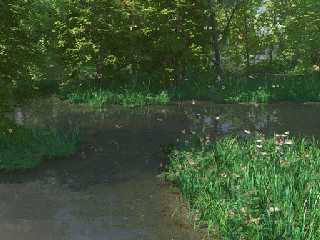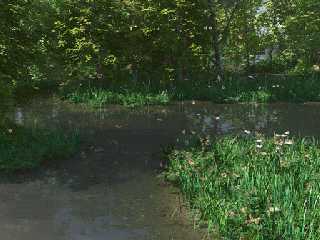 |
 |
|
 |
|
 |
|  |
|  |
|
 |
|
 |
|  |
|  |
|
 |
Hi all,
I want to show someting new on my old boring "warm_up".
The image was made with a 11 point lights to simulate global illumination at
that time.
Christoph Hormann recommended the use of radiosity repeatedly.
Eight days back Kari Kivisalo wrote 1 bounce radiosity would be as fast as
the use of point lights to simulate global illumination.
So I show 2 trials with different rad settings.
The first image was done with simple settings:
pretrace_start 1
pretrace_end 1
count 30
...
recursion_limit 2
low_error_factor 0.5
...
brightness 1.2
The result is similar to using shadowless fill lights, but it rendered
within 16 h (about 4 times faster than the original would have rendered with
AA0.3).
The second image was done with better settings:
pretrace_start 0.08
pretrace_end 0.005
count 120
...
recursion_limit 1
low_error_factor 0.25
...
brightness 1
Much better, but not as good as with faked "global illumination". Render
time was similar to the original (
http://www.irtc.org/ftp/pub/stills/2001-06-30/warm_up.jpg ).
I think, point ligths simulating global illumination can be sometimes better
than radiosity.
Comments?
Norbert
Post a reply to this message
Attachments:
Download 'warm_upRada.jpg' (74 KB)
Download 'warm_upRadb.jpg' (75 KB)
Preview of image 'warm_upRada.jpg'

Preview of image 'warm_upRadb.jpg'

|
 |
|  |
|  |
|
 |
|
 |
|  |
|  |
|
 |
Norbert Kern wrote:
>
> [...]
>
> Much better, but not as good as with faked "global illumination". Render
> time was similar to the original (
> http://www.irtc.org/ftp/pub/stills/2001-06-30/warm_up.jpg ).
>
> I think, point ligths simulating global illumination can be sometimes better
> than radiosity.
>
> Comments?
>
I think it's not that simple, radiosity does not only compute the
influence of diffuse light from sky but also the radiative interaction of
all objects of the scene, something that gets totally lost with shadowless
lights.
Your rad settings seem to use default error_bound of 1.8 which is fairly
high, lowering it could help to bring more structure in the shadowed parts
of the scene.
And of course the finishes probably need to be adapted to the different
illumination for optimal results.
NTL it's nice to finally see this scene with radiosity.
Christoph
--
Christoph Hormann <chr### [at] gmx de>
IsoWood include, radiosity tutorial, TransSkin and other
things on: http://www.schunter.etc.tu-bs.de/~chris/ de>
IsoWood include, radiosity tutorial, TransSkin and other
things on: http://www.schunter.etc.tu-bs.de/~chris/
Post a reply to this message
|
 |
|  |
|  |
|
 |
|
 |
|  |
|  |
|
 |
"Christoph Hormann" <chr### [at] gmx de> schrieb im Newsbeitrag
news:3B8D52BC.4008579A@gmx.de...
>
> I think it's not that simple, radiosity does not only compute the
> influence of diffuse light from sky but also the radiative interaction of
> all objects of the scene, something that gets totally lost with shadowless
> lights.
I used shadowing lights in my fake, but you are right, radiosity does much
more.
Pure global illumination is only helpful in some very special cases.
> Your rad settings seem to use default error_bound of 1.8 which is fairly
> high, lowering it could help to bring more structure in the shadowed parts
> of the scene.
I used error_bound 0.1 in the second image (forgot to mention).
> And of course the finishes probably need to be adapted to the different
> illumination for optimal results.
of course
> NTL it's nice to finally see this scene with radiosity.
ready.
Norbert de> schrieb im Newsbeitrag
news:3B8D52BC.4008579A@gmx.de...
>
> I think it's not that simple, radiosity does not only compute the
> influence of diffuse light from sky but also the radiative interaction of
> all objects of the scene, something that gets totally lost with shadowless
> lights.
I used shadowing lights in my fake, but you are right, radiosity does much
more.
Pure global illumination is only helpful in some very special cases.
> Your rad settings seem to use default error_bound of 1.8 which is fairly
> high, lowering it could help to bring more structure in the shadowed parts
> of the scene.
I used error_bound 0.1 in the second image (forgot to mention).
> And of course the finishes probably need to be adapted to the different
> illumination for optimal results.
of course
> NTL it's nice to finally see this scene with radiosity.
ready.
Norbert
Post a reply to this message
|
 |
|  |
|  |
|
 |
|
 |
|  |
|  |
|
 |
Radiosity lends itself better to architecture than to landscapes. There
isn't even a benefit to the viewer by performing radiosity steps on things
like grass and leaves because the samples are so small. All you really need
is to simulate the hemispherical source of the sky. Now, if there were a
tree stump or large, man-made object in the scene, than radiosity could make
a difference...though in that case I would try rendering just that object
with the sky and saving the radiosity cache file, then load the file back in
with everything visible for the final render. Never really tried it but
that should work.
Anyway, the original version of this scene looks the best IMO.
Post a reply to this message
|
 |
|  |
|  |
|
 |
|
 |
|  |
|  |
|
 |
"Mike Hough" <Ama### [at] aol com> wrote in message
news:3b8d9feb$1@news.povray.org...
> Radiosity lends itself better to architecture than to landscapes. There
> isn't even a benefit to the viewer by performing radiosity steps on things
> like grass and leaves because the samples are so small.
Maybe but radiosity especially with poorer settings changes the colour of
the image considerably and enhances the atmosphere of the image.
Mick com> wrote in message
news:3b8d9feb$1@news.povray.org...
> Radiosity lends itself better to architecture than to landscapes. There
> isn't even a benefit to the viewer by performing radiosity steps on things
> like grass and leaves because the samples are so small.
Maybe but radiosity especially with poorer settings changes the colour of
the image considerably and enhances the atmosphere of the image.
Mick
Post a reply to this message
|
 |
|  |
|  |
|
 |
|
 |
|  |
|  |
|
 |
> Maybe but radiosity especially with poorer settings changes the colour of
> the image considerably and enhances the atmosphere of the image.
You're right, it does create a different look. Kind of impressionist. At
the time I was thinking of it in terms of photorealism and having radiosity
create a more accurate representation of the lighting rather than looking at
it in an artistic sense.
-Mike
Post a reply to this message
|
 |
|  |
|  |
|
 |
|
 |
|  |




![]()